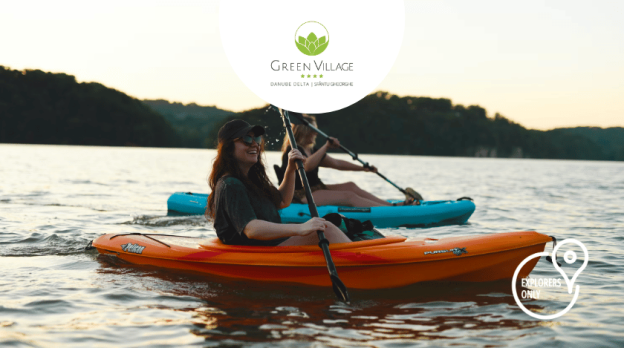There are places an explorer has to go at least once in his life. Places that are home to cultures totally different from the familiar. Places where nature is spectacular and diversity has made its mark not just on customs but on life.
You will find such a place in the Danube Delta, in Sfântu Gheorghe, where Europe’s youngest land awaits you.
Set off to explore the Delta in a kayak and get as close to nature as possible in a memorable experience.
If it’s your first kayak trip, see this article for some tips.
How to launch a kayak?
It is best to choose a shoreline with a gentle/steep incline.
Ask a friend to help you carry the boat to the entry point. Lay it ashore in shallow water perpendicular to the shoreline. (If you are launching the boat into a river or if you have a very long kayak, then a parallel launch might work better). For a perpendicular launch, the bow should face away from the shoreline and the stern should be close to the shoreline (but completely on the waterline). Place one of the paddles under the deck line in front of the cockpit. Get on top of the kayak by sitting on the backrest and stretch your legs into the kayak.
Grab your paddle and use it to kayak past river waves and self-inflicted ones. Then, attach the protective cover, if there is one.
Later, when it’s time to get out of the kayak, simply paddle into launch position, install your outrigger and reverse your steps until you’re back in the kayak.
How to hold the kayak paddles?
Start by gripping your paddle with both hands and centering your paddle body on top of your head. Your hands will be in the correct starting position when your elbows are bent at 90 degrees.
Now lower the paddle and orient it as follows so that you are holding it correctly:
Make sure the paddle blades are aligned with each other. If you notice that the paddles are offset from each other, your paddle may be “feathered”. If this is the case, take a minute to adjust the blades back in line via a knob or a twist setting in the center of the shaft. (Feathered blades cut the wind better, but are more difficult for beginners to use).
Make sure the notched parts of the blades are facing you: Blade curvature is subtle, so watch carefully.
Relax. Form an “O” with your thumb and forefinger, then gently place your other fingers on the rod. Gripping the blade is unnecessary and tires your hands faster.
Safety measures for kayaking
Every time you go out on the water, it’s important to have the essential equipment and clothing with you that we talked about in the previous article. A few additional safety precautions are also necessary on an unguided trip:
Bring a paddling partner. If there is no guide, you should always go with another paddling enthusiast who can call for help or offer assistance.
Make a pact to work together. A friend who is out of your sight or earshot won’t be much help.
Know your distance limit. Unless you’ve taken rescue courses, never go further from shore than you’re easily able to swim. (Areas closer to shore are more interesting anyway.).
If you plan to kayak in the future, consider taking a rescue course. And courses that cover sailing, tides, currents and surfing can help you avoid problems from the start.













